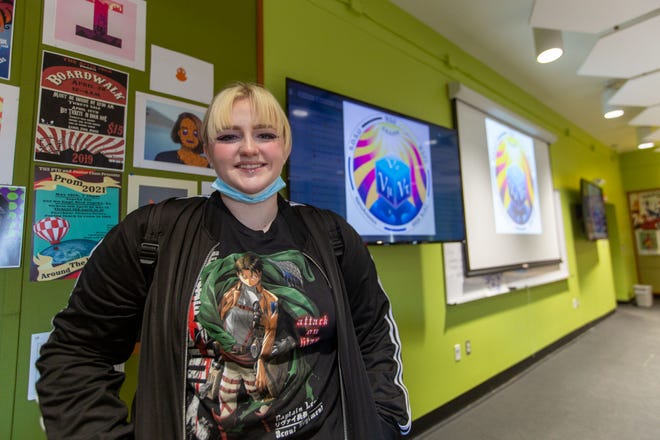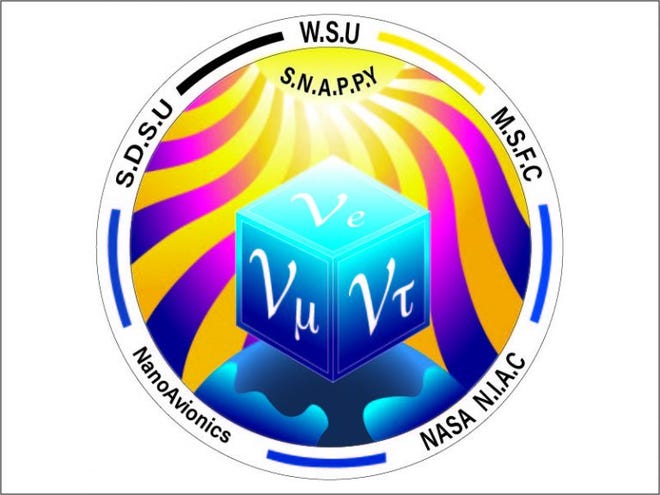[ad_1]
For as long as she can remember, Rylee Salts has had an almost compulsive need to paint a life she sees as a blank canvas.
Her shoes. Her jeans. Little doodles here and there to add a little bit of Rylee Salts-flair to a world that often needs a little bit more color.
“When I see something that’s blank, I feel like it’s not right — that there should be something on it,” the Topeka High sophomore said. “Even if it’s something simple.”
Now, she’ll have a chance to leave her mark on something out of this world.
As part of a statewide contest to design a mission patch for a NASA mission, one of Salts’ designs will be worn by mission support personnel as a satellite launches into Earth orbit to learn more about one of the most abundant, yet hard to study, particles in the universe.
More:‘Banning Transgenderism’ isn’t about discrimination but free speech, says Washburn Republicans chair
Mission to learn more about the sun

The Solar Neutrino and Particle Physics (S.N.A.P.P.Y) mission features research by Wichita State University physics professor Nick Solomey, who was given a $2 million research grant by NASA in April 2021 to continue his work to develop a neutrino detector.
Neutrinos are tiny, elementary particles that blast through space, many of the ones in our solar system coming from the sun.
But even though they’re some of the universe’s most abundant particles, their tiny size means they usually pass straight through most matter, according to NASA. Researching them on Earth requires huge and extremely sensitive detectors, but Solomey’s research proposes launching a space-based neutrino detector.
CubeSat will be an initial mission of a tiny satellite to test the neutrino detector in Earth orbit, ahead of potential future missions to study the sun’s neutrinos more closely to the source.
More:McCarter Elementary knew this Topeka teacher is outstanding, but now the whole state knows it
Ad Astra, and getting Kansas kids to the stars
Since Solomey was tasked with designing the CubeSat test mission patch, he turned to the Ad Astra Kansas Foundation — an organization focused on promoting technology, space research and STEM education in the state — to help get Kansas kids involved in the design and promote the science and space programs at the university.
“It seems like it’s our duty to provide opportunities to Kansas youth that will help them enlarge their world,” Jeanette Steinert, an Ad Astra initiative representative, said in a release. “Engaging students in STEM seems to be one way to do that.”
Over the course of the fall, sixth- through 12th-grade students across Kansas submitted mission patch design ideas, incorporating themes to represent the mission, NASA and Wichita State. A team of Solomey’s graduate assistants then picked a winner and runners-up from the top 20 submissions.
‘Art and math put together — that’s what astronomy is’

At Topeka High, Kris Mandsager’s astronomy class worked with Mona Morrissey’s graphic design class to design submissions for the CubeSat mission.
The students in the astronomy class worked in pods with graphic design students to incorporate design elements that closely matched the mission’s objective. Salts worked closely with Cassius O’Brien-Stiner, a Topeka High senior, on her design.
She credited O’Brien-Stiner for helping her visualize a topic that can be hard to wrap her head around. Salts’ mom, she said, helped her understand the connection between her passion for art and its practical application in astronomy.
“Art and math put together — that’s what astronomy is,” Salts said. “You look at different scales, different stuff like that. That’s all art.”
Salts said she thinks her design stood out because its vibrant colors and flashy design reflected her expressive personality. Morrissey, Salt’s teacher, said the sophomore’s raw talent especially shone.
More:Brad Willson, next Seaman superintendent, vows to serve kids first
“We have a lot of talented students like Rylee who sometimes just don’t find the right class,” Morrissey said. “They just need to find the thing that they’re good at. Rylee found hers, and she’s fallen into her strengths.”
One day, Salts wants to be an art teacher, so she can inspire future students to one day find their own strengths.
But for now, she’s still taken aback that a Kansas high schooler like her designed a mission patch that will feature so prominently in out-of-this-world research.
“It’s insane to think about,” she said. “I was just someone who did something so simple that I do every day — just drawing random, little doodles. And now it’s a really big thing.”
Rafael Garcia is an education reporter for the Topeka Capital-Journal. He can be reached at [email protected]. Follow him on Twitter at @byRafaelGarcia.
[ad_2]
Source link


More Stories
4 Delightful Garden Design Ideas for Your Hospitality Business
Real Estate Investing Contracts on Toilet Paper
Web Design Facts – Following the Golden Rules of Website Design